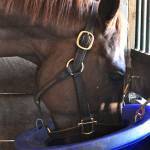Beet Pulp: Energy Source for Horses

Horses with high energy demands, such as performance horses and hard keepers, frequently require concentrates to meet athletic expectations and to maintain condition. If you’re looking to decrease the amount of high-starch concentrates, offering beet pulp can offset the need for cereal grains while supporting a healthy gastrointestinal system.
Offering concentrates fills the gap in many horse’s diets when hay alone provides insufficient calories. In some cases, the starch content of traditional sweet feeds and straight cereal grains can exceed 40% in a horse’s diet, potentially resulting in digestive disorders when fed at high intakes.
Some horses fed these types of diets may require gastrointestinal support due to the possibility of gastric ulceration, hindgut acidosis, and even laminitis.
“Nutritional supplements containing digestive buffers help attenuate the risk of acidosis due to starch fermentation in both the stomach and hindgut. Kentucky Equine Research has several products designed to deliver high-quality ingredients with significant buffering capacity to support total digestive tract health and function,” said Catherine Whitehouse, M.S., a Kentucky Equine Research nutritionist.
To maximize gastrointestinal health while supplying adequate calories to hard-working horses, nutritionists recommend limiting the amount of starch. Even when carefully supplied, some horses cannot tolerate this amount of starch in their diet. To add calories and offset the amount of starch fed, owners can offer vegetable oil or stabilized rice bran. If stabilized rice bran does not work for a particular horse, owners can try another “concentrate-sparing” feedstuff, beet pulp, though stabilized rice bran contains 50% more energy than beet pulp.
In terms of hindgut health specifically, beet pulp recently proved valuable in limiting hindgut dysbiosis that can occur with diets rich in starch and other soluble carbohydrates.* Dysbiosis refers to an alteration in the type and amount of bacteria in the intestinal microbiome that may lead to disease.
In the study, different diets were fed to horses. The beet pulp diet involved 50% hay, 21% barley, and 29% beet pulp, while the high-starch included 55% hay and 45% barley.
When horses were fed the diet with beet pulp, the cellulolytic bacteria in the intestinal microbiome were more numerous than in horses on the high-starch diet; these beneficial bacteria break down fiber. In addition, horses fed beet pulp also produced higher concentrations of volatile fatty acids than horses fed the high-starch diet. Volatile fatty acids produced by bacteria in the hindgut are the primary source of energy for horses.
These results suggest that replacing even a portion of the concentrate with beet pulp can limit hindgut dysbiosis without affecting energy supply. This reinforces the reality that many feeds formulated for hardworking horses contain multiple energy sources, including starch, fat, and fermentable fiber. One of the most oft-used fermentable fibers is beet pulp.
Are you looking for a reputable manufacturer of high-quality, science-based feeds? Look for a Kentucky Equine Research Balance Partner in your area.
*Grimm, P., V. Julliand, and S. Julliand. 2021. Partial substitution of cereals with sugar beet pulp and hindgut health in horses. Journal of Equine Veterinary Science 100:103530.








